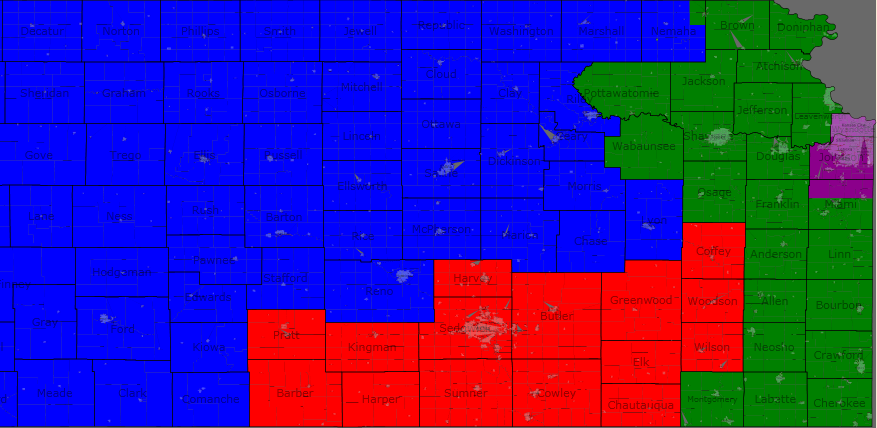In Kansas, redistricting is controlled by the state legislature, with the Governor having veto power. By far the most likely political scenario is that in 2010, Republicans will have a huge advantage in the state Senate (currently 31-9) and a big one in the state House (currently 76-49) and likely a new Governor in conservative Republican Sam Brownback (ugh) unless Democrats find a miracle candidate to take him on.
But one-party control has its downsides: namely, a long-running split between the party’s hardcore conservatives and its moderates, who regularly side with Democrats to either make mischief or enact good policy, depending on your point of view. It plays out in the legislature regularly, and in the congressional seats occasionally.
The most recent example is the 2nd District’s Nancy Boyda, a Democrat who knocked out the very conservative Jim Ryun in 2006, 51-47. “Moderate” Lynn Jenkins edged out Ryun in the 2008 Republican primaries and was able to bring enough Republicans back into the fold to defeat Boyda 51-46.
Here’s the thing: If (conservative) Brownback is elected Governor in 2010, the last thing he’ll want to do in 2011-2012 is a pick a fight with legislators over redistricting.
A Gov. Brownback (ugh) will have his hands full pushing through a conservative agenda over the feisty moderates (whose main base, suburban Johnson County, is going to get quite a few more seats regardless). Moderate Republicans and Democrats share a lot of redistricting aims–they want competitive seats, basically. Make seats too heavily Republican and conservatives will take over, too heavily Democratic…well, that’s not really a possibility in Kansas.
Overall, Kansans do tend to be fairly civic-minded about redistricting and don’t do obvious gerrymanders, using fairly balanced “select committees” of legislators to do the grunt work. Finally, legislators also put maintaining the core of existing districts into the redistricting guidelines for last time, so I’d bet that’s likely to show up again.

The Big First – District One – map color: blue [irony alert!] – The person in this seat basically has a space waiting for them on the Agriculture Committee. And it will be the person who wins the Republican primary for this open seat in 2010. This district is about as red and rural as it gets–and like many rural areas, it’s bleeding population.
Adds: bits of Geary & Nemaha, all of Riley
Loses: Pratt, Barber, Waubaunsee, the rest of Greenwood
Old PVI: R+23
New PVI: R+22
District Two – Lynn Jenkins (R) – map color: green – At PVI+9, it’s already the 2nd most Dem district (tells you something about KS right there), but there’s nowhere else to put the rest of liberal Lawrence now that the 3rd district has grown too populous for it. Based on Moore’s 2008 numbers here, that’s a net of about 13,000 votes in the D column flooding the district (with 27000 votes total and a 71-24 split). Jenkins beat Boyda by 13,500 votes in 2008. D’oh.
The only help Republicans can offer is tinkering around the edges–taking out Topeka would be the only way to really affect the composition and that’s out of the question from several standpoints. It’s just unfortunate for the Great White Dope that her district completely surrounds the fastest-growing and bluest one in the state. That said, moderate Republicans should (at least in theory) love this district. They might still be able to edge out an incumbent Democrat (barely), but a conservative could be defeated in a general election.
Adds: the rest of Douglas County (net 13000 D), Wabaunsee (net 1300 R), Montgomery (net 5000 R)
Loses: Riley (net 1000 R), Coffey (net 1400 R), Woodson (net 500 R), Wilson (net 1300 R)
Old PVI: R+9
New PVI: R+5
District Three – Dennis Moore (D) – map color: purple – Even if Republicans wanted to get rid of the delegation’s sole Democrat, it would be nearly impossible. To do it, you’d have to move out both Douglas & Wyandotte counties and then tack on a dozen or so rural ones. Not really a “community of interests” between the state’s richest, most populous suburban county and slew of relatively poor rural counties.
So instead, the district drops the rest of Douglas and picks up a few sparsely-populated (for now) bits of Miami County. It’s enough to shift the PVI needle a few clicks to the right, but not enough to dislodge Moore, who won Johnson County 51-45 and Wyandotte 75-21. Still, a moderate Republican could definitely pick up this seat if the 63-year-old Moore retires. Then again, so could a Democrat.
Old PVI: R+3
New PVI: R+5
District Four – map color: red – Centered on the slow-growing Wichita metro area, the Fightin’ Fourth has to add a few rural counties and becomes a bit redder. Even if state Rep. Raj Goyle can pull off an upset in 2010 in the open seat race here, he’ll be even harder-pressed to win here after redistricting.
Adds: Coffey, Woodson, Wilson, Pratt, Barber
Loses: Montgomery
Old PVI: R+14
New PVI: R+15
Final score: Two seats that a moderate Republican or Democrat could possibly win, and two seats they almost certainly couldn’t.